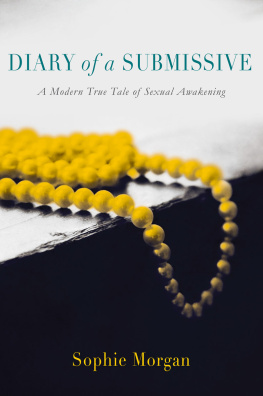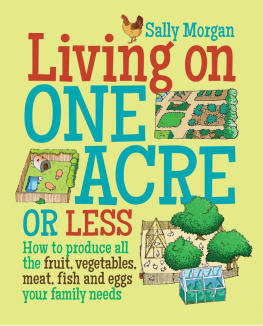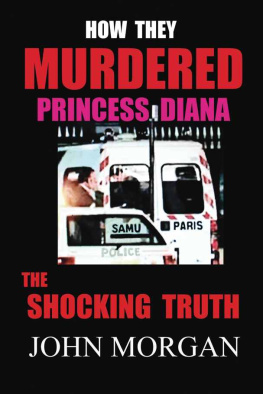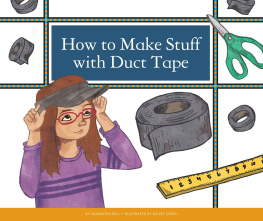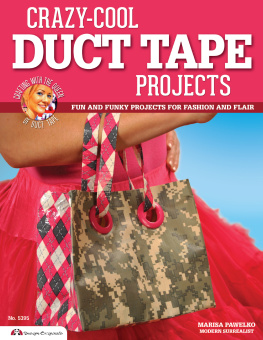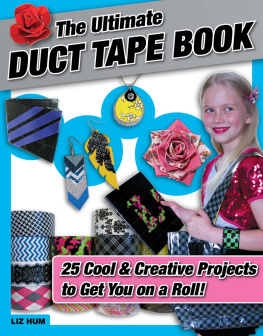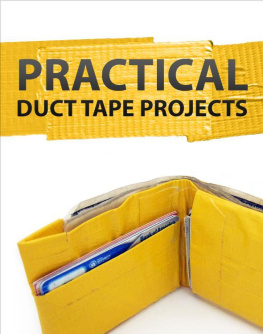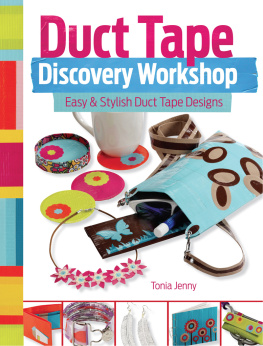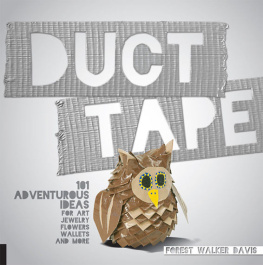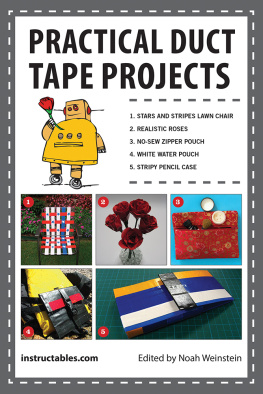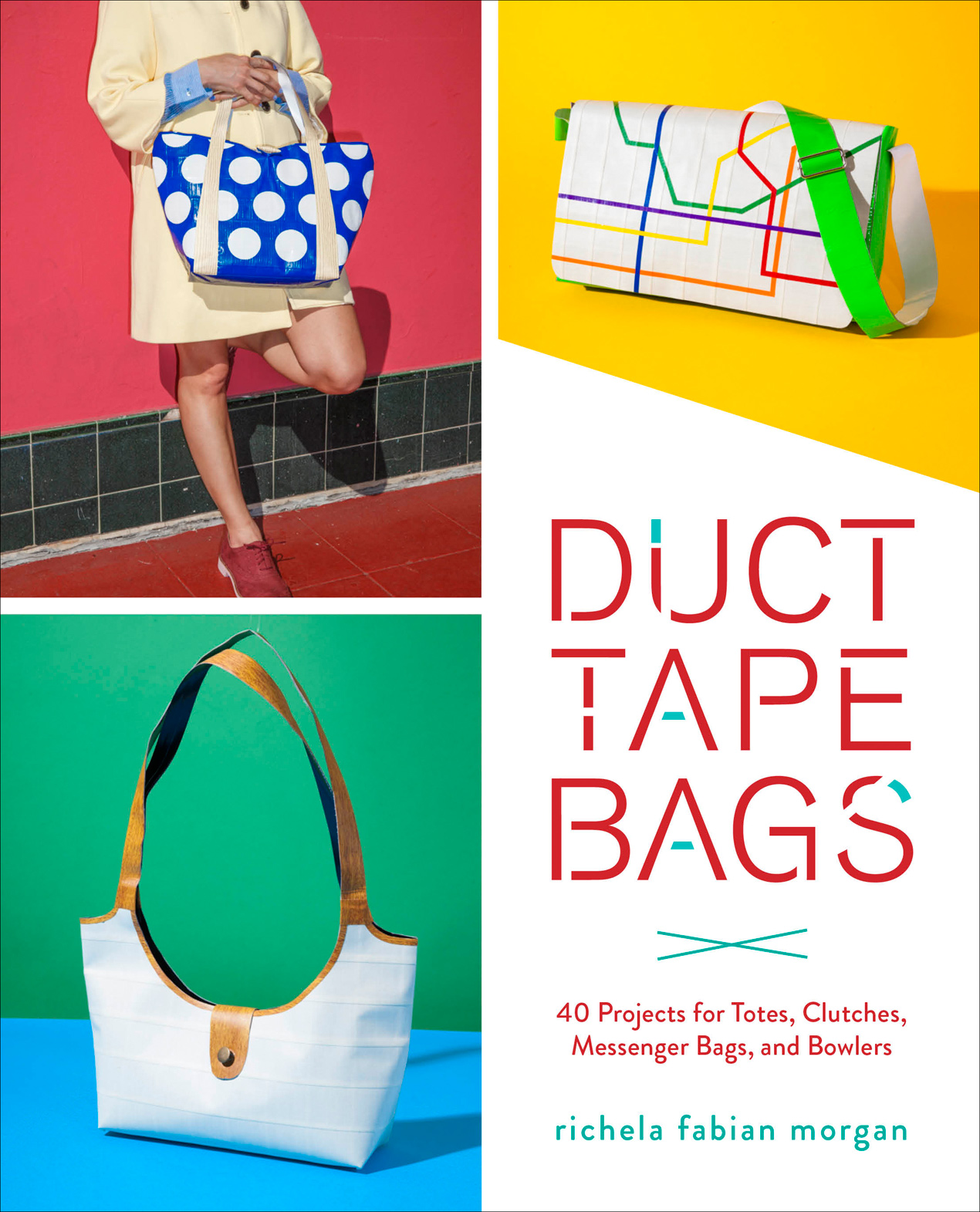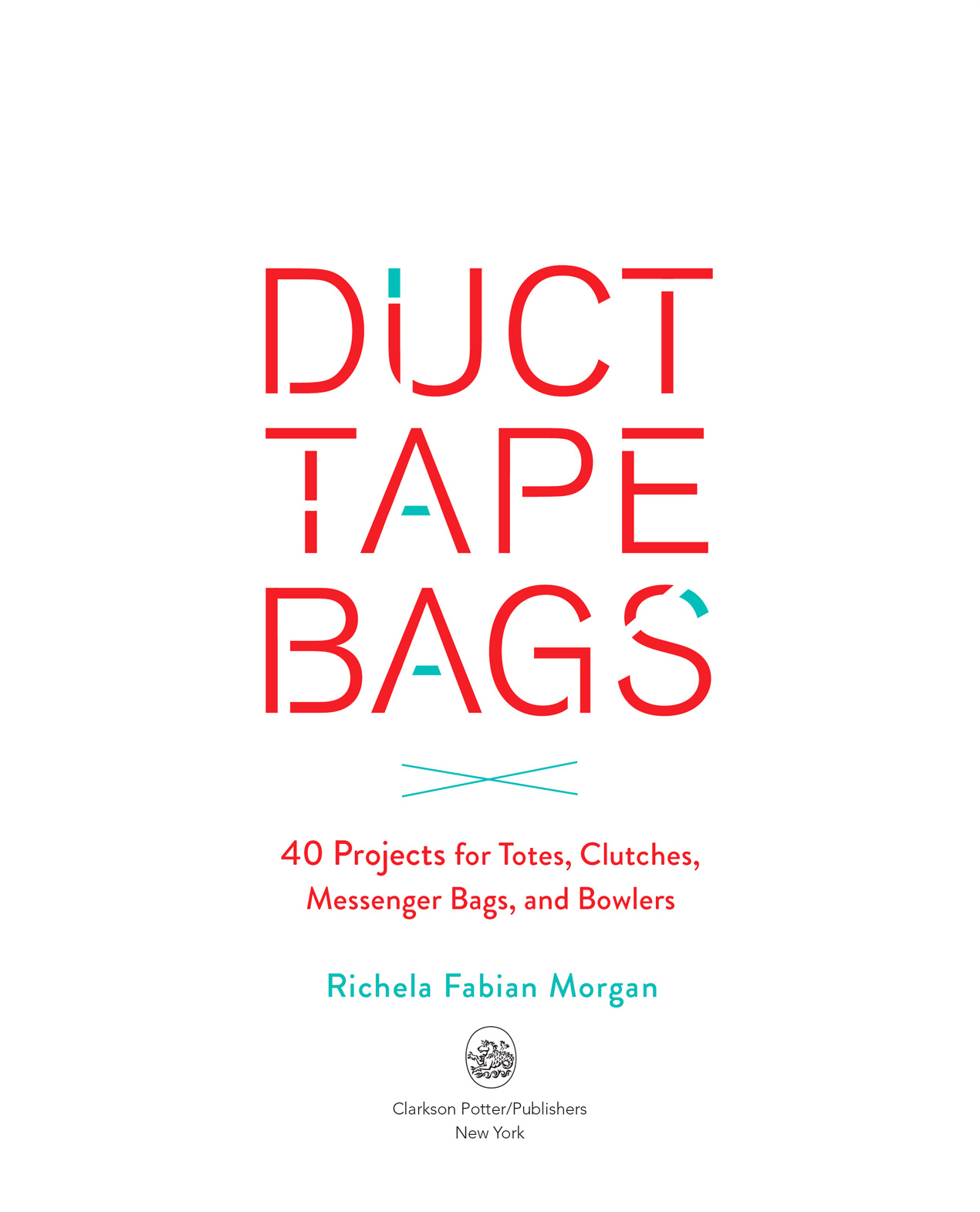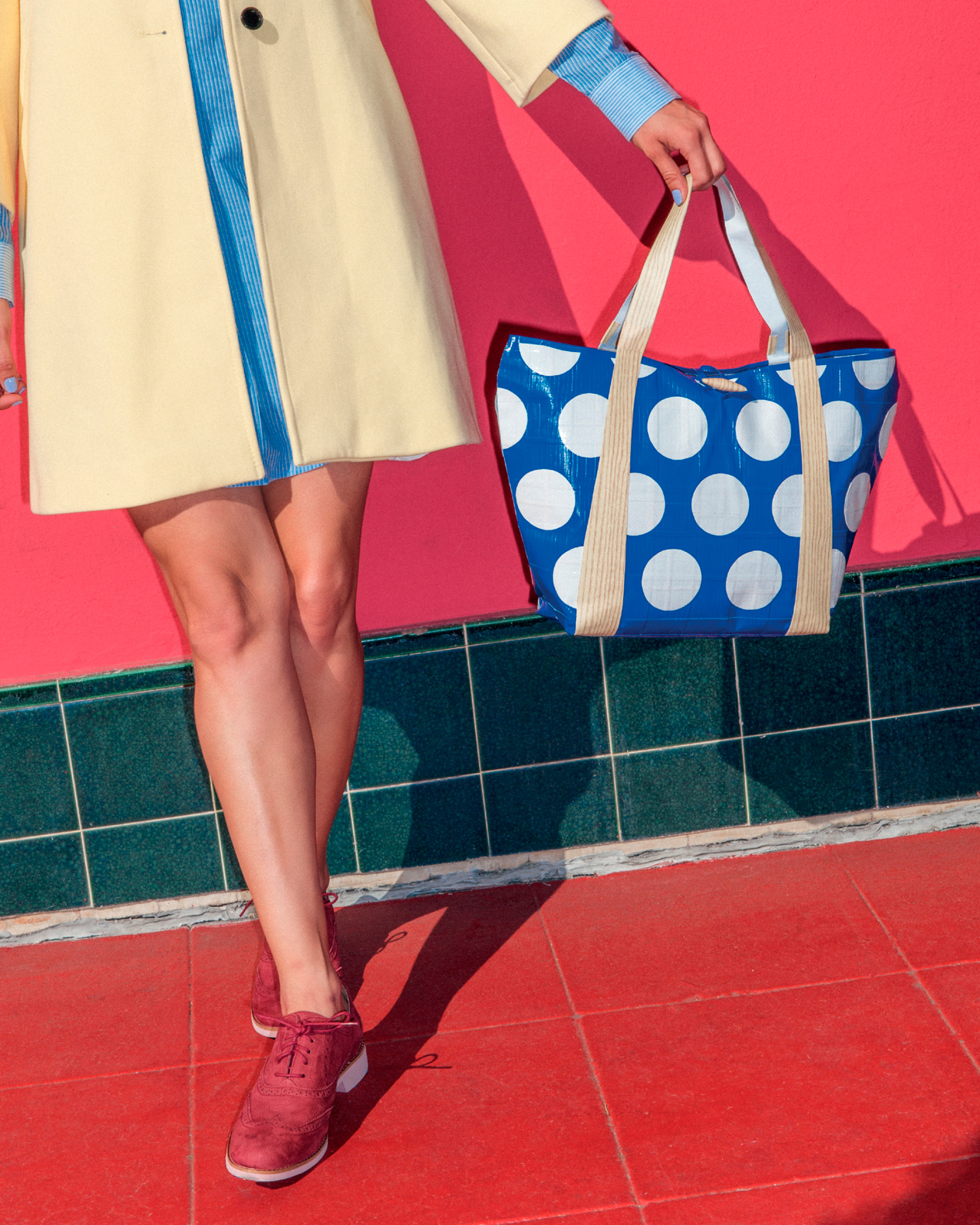Copyright 2016 by Richela Fabian Morgan
Principal photography 2016 by Stephanie Gonot
All rights reserved.
Published in the United States by Clarkson Potter/Publishers, an imprint of
the Crown Publishing Group, a division of Penguin Random House LLC, New York.
www.crownpublishing.com
www.clarksonpotter.com
CLARKSON POTTER is a trademark and POTTER with colophon is a
registered trademark of Penguin Random House LLC, New York.
Library of Congress Cataloging-in-Publication Data
Names: Morgan, Richela Fabian.
Title: Duct tape bags / by Richela Fabian Morgan.
Description: First edition. | New York : Clarkson Potter/Publishers, an imprint
of the Crown Publishing Group, a division of Penguin Random House LLC, [2016]
Identifiers: LCCN 2015027602 | ISBN 9780553448320 | ISBN 9780553448337
Subjects: LCSH: Handbags. | Tape craft. | Duct tape.
Classification: LCC TT667 .M665 2016 | DDC 745.59dc23 LC record available at
http://lccn.loc.gov/2015027602
ISBN9780553448320
eBook ISBN9780553448337
Cover design by Jess Morphew and Sonia Persad
Cover photography Stephanie Gonot
v4.1
prh
For my mom and dad: I miss you every day.
And for Ed GrandDad Morgan
INTRODUCTION
THE BEAUTY
OF DUCT TAPE
Bags are some of my favorite things. I feel that I should have the right to own as many of them as I want. Why? Because they make me happy.
To offset the cost of what can be an expensive collection, I make my own bags out of many materials. Because the closest fabric shop is at least a forty-minute drive from my house, I am more likely to search for raw materials in a grocery or hardware store. What Ive discovered is that the most versatile material for making a bag is duct tape.
When duct tape is layered together into large double-sided pieces, it can be cut like cloth. But unlike traditional fiber-based material, this duct tape fabric does not need to be sewn with a needle and thread. The seams are held together with more duct tape, which means you wont be searching for the dreaded seam ripper after belatedly discovering a mistake.
The first time I made a duct tape fabric, I used black duct tape because it was a safe choice. Black matches everything, right? The fabric also resembled black patent leather, which I did not expect. After transforming it into a simple clutch bag, I was surprised by how little it resembled duct tape. It easily became my everyday purse. It wasnt long before I began trying out other colors and patterns of duct tape and making bags of various sizes and shapes.
Speaking of colors and patterns, you have so many offerings to choose from now: fabric-inspired options like chevron, plaid, argyle, linen, denim, leopard print, and camouflage. Ive also seen tape named after wood: Brazilian rosewood, mahogany, and white oak.
Duct tape can be woven, striped, made into a faux patchwork, gathered into ruffles, or cut into fringes. It can be divided into pieces and fitted together like a jigsaw puzzle. It can be made into petals, which you can use like appliqu. All of this may sound as if its delicate or intricate work, but the techniques in this book will show you how to do it all. You just need to remember that its duct tape and almost any problem can be fixed. So dont be afraid to dive right in.
The information in the . Then you are ready to start crafting any style of bag.
You can undo something in the middle of a project to change a color or a shape. You can add more duct tape fabric if you belatedly discover that your measurements are wrong. You dont have to be intimidated; you can simply begin and play.
THE ESSENTIALS
BASIC TOOLS
OF THE TRADE
So what do duct tape crafters use besides duct tape and their massive arm strength? Here are lists of my must-haves and nice-to-haves.
Before diving headfirst into the colorful world of duct tape bags, youll need to set up your crafting area with the right tools and materials. And its also helpful to see how to actually make a duct tape fabric, which can be used for many things besides bags. Yes, you can buy a few rolls of duct tape and start crafting, but you can avoid wasting your materials by knowing the essentials beforehand.
YOU MUST HAVE
PARCHMENT PAPER (ALSO KNOWN AS BAKERY PAPER): this is not to be confused with traditional writing parchment, which is made from animal skin. Parchment paper is made with silicone and is nonstick. When making duct tape fabrics or duct tape stickers, strips of tape are placed on top of parchment paper and then later peeled off. Parchment paper is available at grocery stores; the standard roll size is 15" (38cm) wide.
SELF-HEALING CUTTING MAT, at least 18" 24" (45.5cm 61cm): duct tape will stay put but also will peel off with ease when placed on top of it.
SCISSORS, at least 6" (15cm) long: these are best for cutting strips off a roll or cutting down large duct tape fabrics into smaller pieces.
CRAFT KNIFE WITH EXTRA BLADES (size 11): use with a metal ruler to cut straight edges on duct tape fabrics.
METAL RULER WITH CORK BACK, 12" (30.5cm): use with a craft knife to make straight edges on the duct tape fabrics. The blade of the craft knife moves against the edge of the ruler as it cuts the fabric below it. The cork back prevents the ruler from moving.
GRAPHITE PENCIL: this is for tracing and drawing on top of parchment paper. Ink pens and markers will run, while the graphite of a pencil will adhere to the surface.
BALLPOINT PEN
GREASE PENCIL: also known as a China marker, this is for tracing a bag shape onto a duct tape fabric and making tick marks. It comes off easily with a little bit of oil.
FLAT-NOSE PLIERS: use to attach the store-bought closures to the bags.
HAMMER: use to attach the jeans button closure and the grommets to the bags.
IT WOULD BE NICE TO HAVE
DETAIL SCISSORS, spring-loaded with 3" (7.5cm) blade: these types of scissors are usually found in the floral-arrangement section of crafts stores or the gardening section of hardware stores. They are fantastic for cutting out intricate shapes.
OVERSIZE METAL RULER WITH CORK BACK, 24" (61cm) or longer: a bigger ruler makes cutting long lines easier, but its not necessary.
STENCILS OF BASIC GEOMETRIC SHAPES (AND IN VARIOUS SIZES): although you can use cans or bottle caps to trace circles, stencils are more convenient.
CIRCLES INKING TEMPLATE, which is a stencil that can be found at arts and craft stores. They make tracing circles a lot easier and more accurate, sometimes down to the 32ndth of an inch.


